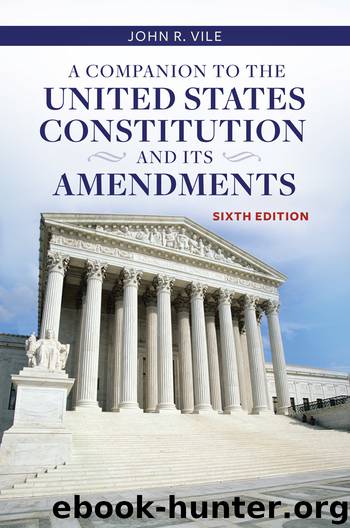A Companion to the United States Constitution and Its Amendments by Vile John R.;

Author:Vile, John R.;
Language: eng
Format: epub
Publisher: ABC-CLIO, LLC
Published: 2015-10-04T16:00:00+00:00
THE EXCLUSIONARY RULE
The Fourth Amendment does not specify what will happen when police officers violate the amendment and make unreasonable searches and seizures or conduct general searches without probable cause. One possible remedy is for victims to initiate civil actions against the officers involved in the illegal activity. Victims (especially when they prove to have been guilty of illegal activity) often find it difficult to win such cases, however, and monetary compensation may provide little relief for persons emotionally traumatized by an illegal search.
Recognizing such problems, courts have enforced the exclusionary rule. The Supreme Court applied this rule to the national government in Weeks v. United States (1914) and to the states in Mapp v. Ohio (1961). It prohibits prosecutors from introducing evidence at trials that officers have seized illegally. Although such exclusion does not void the original intrusion into privacy, judges have enforced this law both to deter future illegal conduct and to keep courts free of the taint of wrongdoing. More negatively, the exclusionary rule sometimes excludes probative evidence and allows guilty individuals to go free.
Critics have not succeeded in eliminating the rule, but courts have limited its application in a number of circumstances. In Nix v. Williams (1984), for example, the Supreme Court established an “inevitable discovery” exception. In this case the justices ruled that prosecutors could introduce the body of a ten-year-old murder victim. Although her murderer had taken officers to the scene as the result of what the courts later decided was an improperly obtained confession, search parties were in the vicinity, the victim’s body was in plain view, and, since the weather was freezing, searchers would almost surely have discovered the body in pretty much the same condition as the officers found it. Similarly, in United States v. Leon (1984) and Massachusetts v. Sheppard (1984), the Court established a “good faith” exception to the exclusionary rule, which exempted officers from responsibility for flaws in warrants when they acted in “good faith.”
Amendment V. No person shall be held to answer for a capital, or otherwise infamous crime, unless on a presentment or indictment of a Grand Jury, except in cases arising in the land or naval forces, or in the Militia, when in actual service in time of War or public danger;
Download
This site does not store any files on its server. We only index and link to content provided by other sites. Please contact the content providers to delete copyright contents if any and email us, we'll remove relevant links or contents immediately.
Day by Elie Wiesel(2596)
The Age of Genius by A. C. Grayling(2393)
Gideon's Spies: The Secret History of the Mossad by Gordon Thomas(2238)
The Gulag Archipelago (Vintage Classics) by Aleksandr Solzhenitsyn(1987)
FATWA: Hunted in America by Pamela Geller(1927)
Columbine by Dave Cullen(1767)
Men Explain Things to Me by Rebecca Solnit(1609)
The Rule of Law by Bingham Tom(1594)
Examples & Explanations: Administrative Law by William F. Funk & Richard H. Seamon(1552)
Anatomy of Injustice by Raymond Bonner(1532)
Three Cups of Tea by Greg Mortenson(1518)
That Every Man Be Armed by Stephen P. Halbrook(1480)
ADHD on Trial by Michael Gordon(1474)
The Source by James A. Michener(1459)
Gideon's Spies by Gordon Thomas(1425)
Future Design by Unknown(1386)
Palestinian Walks by Raja Shehadeh(1363)
Constitutional Theory by Carl Schmitt(1347)
Fast Times in Palestine by Pamela Olson(1335)
